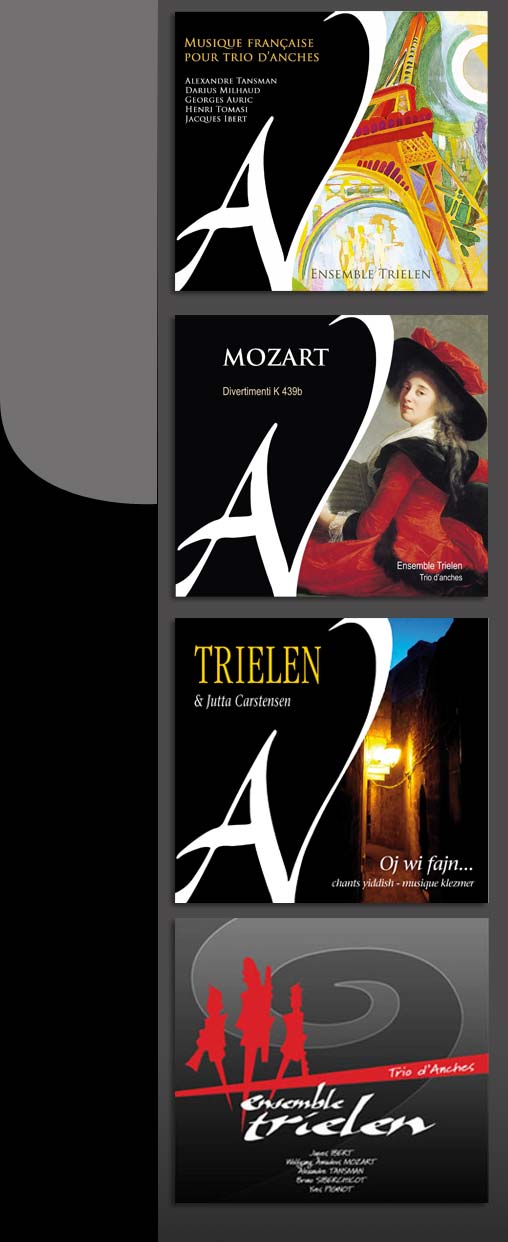Set of records
The last recording of Trielen Ensemble - Reed Trio will be available at spring 2015 and will be devoted to French composers of the early twentieth century with with Auric, Tomasi, Ibert and Milhaud Tansman.
Ad Vitam records (Harmonia Mundi Distribution)
In France, during the twenties, breaking with the musical heritage of the ninetieth century and part from Debussy's aesthetics, a generation of independant and anti-conformist composers was born. Coming from various horizons but gathered by strong similarities of characters, they did privilege a straight musical art devoid of glossing over, reflection of everyday life, the « real life ». Some of them were inspired by the Reed Trio gathering oboe, clarinet and bassoon, and, for this formation, they composed pages full of flavour, fresh fineness and kind irony.
By their originality and richness, the reed trios written from the thirthies till after-war give by themselves a real status to this formation, while obviously giving the spirit of independence that was the French artists' one by that time.
« The Reed Trio » of my father, composed in 1949 and created on the Radio on the twelfth of June 1950 is very often performed and has been the subject of several recordings. But I must say that I am especially full of enthusiasm with the brillant performance of the Ensemble Trielen. On the hand, by the wonderful virtuosity of the musicians and their dynamism in the two quick movements (the Scherzino and the Finale) and, on the other hand, by the way they let poetry filter out in the cantabile character, a melancholy and dreamy one in the two slow movements (Dialogue and Aria), thanks to an exceptional quality of the tones and a deep musicality. Warm congratulations and sincere thanks !
Mireille Tansman
_
This is in Paris, in « Jardin du Luxembourg », one of my father's most favourite places in the capital, that I am transported by his « Concert Champêtre », ideally performed by the trio « Trielen ». The musicians' playing touches to the sculptured faun's perfection, raising in the entrance of the Garden. This very faun who gives back exhilaration to all the characters, present, dreamed or missing, all evokated while a Summer moment when nostalgia also shadows conversations, faces...
Claude Tomasi
_
If we want to understand my grandfather, Jacques Ibert, his character and his music, we can't disregard emotion. He used to write according to the requirement of his sensibility. The trio Trielen has perfectly understood that and its rendering of the « Cinq Pieces en Trio » composed in 1935 carries me to Summer, in the Norman country where my grandfather enjoyed spending his holidays. Pictures, colours ans smells too quite naturally appear.
Véronique Ibert Péréal
Mozart - Divertimenti K 439b
Record of Ensemble Trielen with the label Ad Vitam - Harmonia Mundi
Since march 2012
W.A Mozart and his friend, the clarinettist Anton Stadler take up Freemasonery nearly simultaneously in 1784 and 1785. Their artistic and brotherly collaboration probably began as soon as Stadler sets in the Court of Salzburg in 1777 before this one joins the Court of Vienna in 1780 in the Emperor’s Harmony. Mozart who used the clarinet for his Divertimento K.113 for the first time in 1771, will never stop appreciating and valuing it until his death. He obviously writes to his father: “Oh! If we only had clarinets! - You can’t imagine the marvellous impression a symphony makes when there are flutes, oboes and clarinets !”
It’s probably thanks to Anton Stadler and his brother Johan Nepomuk that Mozart discovered a “low” variant about the clarinet – the basset horn – and used it in the Serenade for thirteen instruments K.361 for the first time in 1781, just as he did in the Idomeneo ballet music. In that very precise context, Mozart composed a series of 25 independent works for three basset horns between 1784 and 1786 which will be gathered together into Five Serenades or Divertimenti, each one composed of five movements K.439b (fluctuate appellations according to the publishers of that time). Undoubtedly, these works were composed during Masonic rituals and played by the Stadlers, and also probably by two other “companions” passing through Vienna (Anton David and his pupil Vincent Springer) on Theodore Lotz’s instruments, a Viennese factor.
While more than two hundreds centuries, a lot of transcriptions were born : three clarinets – two clarinets and bassoon – oboe, clarinet and bassoon – two violins and cello and so on … In this record, the Ensemble Trielen purposes you a Reed Trio version but, by this time, as they say, on “modern” instruments. Of course, the interest of this work lies in the union of the tones with the resonant textures between the double-reed instruments (the bassoon and the oboe) and the clarinet, a single reed instrument. So, we had to part with the aesthetic universe of the three basset horns (uniformity of their tones, ways of their attacks and similar manners of playing linked to their instrumental texture), in order to bring out the different kinds of tones and own manners of playing of each instrument composing a Reed Trio, while more closely respecting the text in its own phrasing.
Trielen & Jutta Carstensen
Record of Ensemble Trielen with Jutta Carstensen with the label Ad Vitam - Harmonia Mundi
Since september 2009
>> listen to excerpts from the disc
The extraordinary energy of Klezmer music joined to the musical accompaniment of the Yiddish
language - able to provide us so many emotions - are served here by “an unusual Ensemble”, giving
way to a free ornamentation, in order to better translate the spontaneity, the humour or the
infinite sadness of these musical witnesses, where virtuosity, inventiveness and improvisation are
always required.
The first record of Ensemble Trielen, brought out in December 2006, offers you a various program consisting of works of Jacques Ibert, W.A. Mozart, Alexandre Tansman, Brunot Siberchicot and Yves Pignot.


